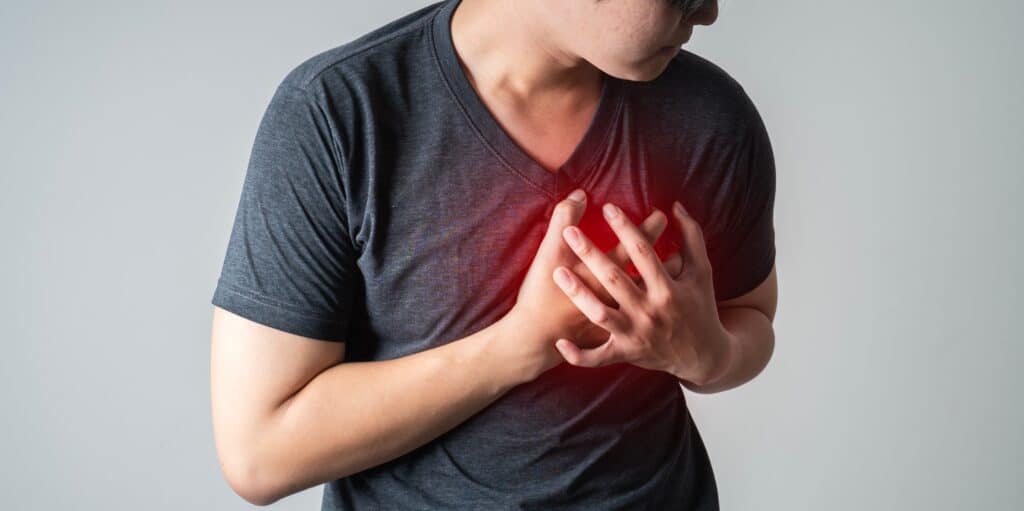
Eddy, a 19-year-old, was brought to the ED complaining of the sudden onset of retrosternal chest pain and shortness of breath. The pain was sharp, made worse by deep inspiration, and swallowing. He reported a mild, dry cough but denied trauma, fever, recent infections, or strenuous exercise. His voice sounded slightly hoarse.
On examination, he appeared anxious, with slightly fast respirations but no increased effort. His vital signs were also normal, other than mild tachypnea. Palpation of the neck revealed crepitus (subcutaneous emphysema), and auscultation revealed a “Hamman’s crunch” — a crunching, rasping sound synchronized with the heartbeat, heard over the precordium. His lung sounds were clear.
Imaging in the ER confirmed the presence of a pneumomediastinum, which appeared to be spontaneous in this case.
The mediastinum is the central compartment of the thoracic cavity, situated between the two pleural sacs which house the lungs. It contains the heart, great vessels, trachea, main bronchi, esophagus, nerves, lymphatic structures, and the thymus gland in children (mostly replaced by fat in adults). A pneumomediastinum is the abnormal collection of air in the mediastinum.
Spontaneous pneumomediastinum is fairly rare, especially in healthy people. The incidence is approximately less than 1 in 44,000. It predominantly affects young males, particularly adolescents, and young adults aged 17 to 25.
Risk factors include asthma, tobacco or cannabis use, vigorous coughing, vomiting, intense physical activity, or activities that cause a Valsalva maneuver (e.g., weightlifting). However, many cases, like this young man, occur without a clear precipitating factor.
The pathogenesis of SPM revolves around the “Macklin effect,” which describes alveolar rupture due to a sudden increase in intra-alveolar pressure relative to the surrounding interstitial pressure. The air leaks from the alveoli into the interstitium, following the bronchovascular sheaths toward the mediastinum.
Triggers such as coughing, vomiting, or sneezing can transiently elevate intrathoracic pressures, promoting this process. Once in the mediastinum, the air can dissect into surrounding tissues, causing subcutaneous emphysema and, in severe cases, may spread to the pericardium or retroperitoneum.
Unlike secondary pneumomediastinum, which results from trauma, surgery, or esophageal rupture (e.g., Boerhaave syndrome), SPM occurs without an external cause.
The management of spontaneous pneumomediastinum is often conservative: patients are typically just observed, and pain is usually treated with non-opioid medication. The condition most often resolves on its own. However, more severe cases are treated in the hospital with high-flow oxygen therapy to help “wash out” nitrogen from the tissues, with the resorption of free air.
Fortunately for this patient, his presentation was fairly mild. He was watched overnight to make sure it wasn’t expanding or developing a complication such as tension pneumothorax (unlikely in spontaneous cases), and then sent home. He was fully recovered in about a week.
Sources and More Information
Alemu, B.N., Yeheyis, E.T. & Tiruneh, A.G. Spontaneous primary pneumomediastinum: is it always benign?. J Med Case Reports 15, 157 (2021).
https://jmedicalcasereports.biomedcentral.com/articles/10.1186/s13256-021-02701-z. Accessed April 28,2025.
Sahni S, Verma S, Grullon J, Esquire A, Patel P, Talwar A. Spontaneous pneumomediastinum: time for consensus. N Am J Med Sci. 2013 Aug;5(8):460-4. https://pmc.ncbi.nlm.nih.gov/articles/PMC3784922/. Accessed April 28, 2025.
Talwar A, Rajeev A, Rachapudi S, Khan S, Singh V, Talwar A. Spontaneous pneumomediastinum: A comprehensive review of diagnosis and management. Intractable Rare Dis Res. 2024 Aug 31;13(3):138-147. https://pmc.ncbi.nlm.nih.gov/articles/PMC11350202/. Accessed April 28, 2025.

